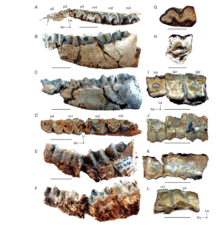| Diplasiotherium | |
|---|---|
 | |
| Fossils of Diplasiotherium pampa, from the Cerro Azul Formation | |
| Scientific classification | |
| Domain: | Eukaryota |
| Kingdom: | Animalia |
| Phylum: | Chordata |
| Class: | Mammalia |
| Order: | † Litopterna |
| Family: | † Proterotheriidae |
| Subfamily: | † Proterotheriinae |
| Genus: | † Diplasiotherium Rovereto, 1914 |
| Type species | |
| †Diplasiotherium robustum Rovereto 1914 | |
| Species | |
| |
Diplasiotherium is an extinct genus of litoptern belonging to the family Proterotheriidae, that lived between the late Miocene and the early Pliocene (in the SALMAs Huayquerian and Montehermosan). [1] The fossils of this animal have been found in Argentina, in the Monte Hermoso Formation. [2] [3]
Diplasiotherium is distinguished from other proterotheriids by the crown of its molars, which were higher than in other related genera (protohypsodont), and by its larger body size; the species D. robustum reached approximately 395 kilograms (871 lb) in weight, making it the largest known proterotheriid. [1] [4]







